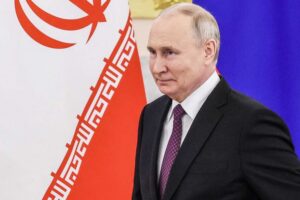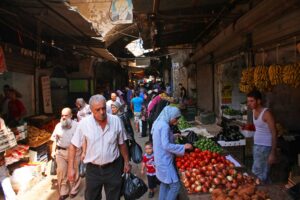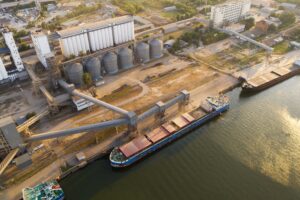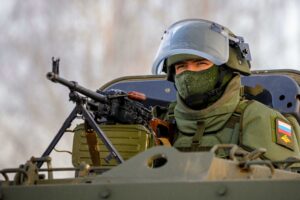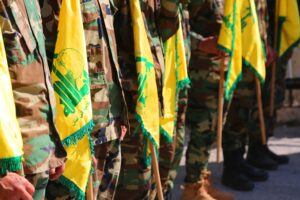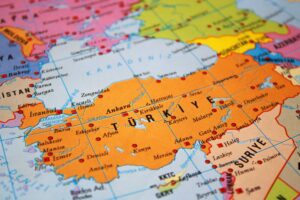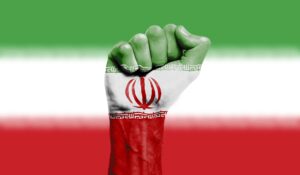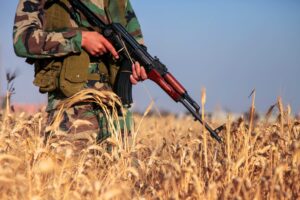The Bedouin of Syria do not get much international media coverage but they continue to maintain a significant presence in the country. Their self-identity is not always in step with perceptions of them by the national government or international bodies. Much contemporary research on the Bedouin of Syria focuses on questioning many of the age-old assumptions concerning the nature of the mobile people who inhabit the semi-arid land of the Syrian Badia[i] as well as the ways in which they (the Bedouin) manage themselves or are managed and controlled by the state. There are two areas of interest or concern with regards to the Bedouin: one revolves around concepts of identity, revisiting the meaning of being tribal, Bedouin, nomadic and pastoral while the other area is what might be called modernization, progress or development. Both of these interests overlap, with the notions of tribe and ‘tribalness’ intimately tied up with socio-political understandings of who are the inhabitants of the Badia, and the out-dated typologies of nomadism and settlement, as well as concerns with traditional rights and knowledge.[ii] After nearly a decade of armed conflict in Syria, which has impacted not only on settled urban communities but also the rural and herding sectors of Syrian society, it is worthwhile to examine the adaptive strategies of the Bedouin to the most recent drought and the on-going armed conflict.
Bedouin Identity
The Bedouin regard themselves as organized into segmented kin-based lineages and tribes with allegiance and sovereignty held by majority consensus in a named leader or shaykh.
The term ‘Bedouin’ is a French language derivative of the Arabic word, bedu, meaning someone who lives in the Badia. It is used to differentiate between those peoples whose livelihood is based upon the raising of livestock by mainly natural graze and browse in the semi-arid steppe land and those who have an agricultural or urban base (hadar). Furthermore, the Bedouin regard themselves as organized into segmented kin-based lineages and tribes with allegiance and sovereignty held by majority consensus in a named leader or shaykh. These tribal leaders maintain their position by dint of a moral authority which can be augmented by good behaviour and decision-making or lost through poor behaviour. Today, Bedouin societies are found in the semi-arid and arid steppe regions of Arabia and North Africa as well as along the Mediterranean margins of rain-fed cultivation. Bedouin living in such areas tend to move as dictated by the availability of pasture and sometimes seasonal heavy morning dew (occult precipitation). Often, they sow barley and other grains along their migration routes which they harvest on their return to winter camping areas or they have access to date gardens.
Bedouin societies are always linked to other non–pastoral societies by economic, social, and political relations. In the local context, a ‘Bedouin’ is a regional specialist in livestock breeding whose closest social and political ties are with his/her pastoral kinsmen (i.e. tribes). Change and adaptation are key aspects of Bedouin livelihood strategies and in the current global economy, many Bedouin have sought out multi-resource strategies, seeking work in related activities such as transport and commerce, and entering into the unskilled daily wage labour market in construction and agriculture. Some have commercialized aspects of their culture in order to buy into the growing demand for native trinkets in the expanding eco-tourism market in the Middle East and North Africa (Cole and Altorki, 1998). Others have settled and become less mobile. However, regardless of their multiple occupations and residence patterns, they remain Bedouin culturally as long as they maintain close social ties with pastoral kin and retain the local linguistic and cultural markers that identify them as Bedouin.
Bedouin livelihoods and modern concepts of development
The primary economic activity of the Bedouin and the culturally significant marker for self- identification is animal husbandry of sheep, goat, and camel. At the core of this way of life is migration of herds determined by the seasonal variability of pasture and water. Because water and grass can be in short supply in a particular area at the same time that it is abundant elsewhere, survival of herds and herders makes movement from deficit to surplus areas both logical and necessary. Over the past fifty years, trucks and other motor vehicles have come to replace camels as beasts of burden (Chatty, 2013 [1986]). Today, the truck is often used to bring feed and water to the herds in the desert. Furthermore, the truck has allowed the Bedouin to be more mobile than in the past, permitting some to settle for much of the year in permanent villages (especially for the young and the old), while still maintaining access to water, pastures, herds, and places of employment beyond the arid steppe land that is their home.
Each Bedouin group seeks to establish a definite zone of control with well-understood, though often variable, limits and certain rights of use denied to other Bedouin groups.
Each Bedouin group seeks to manage a land area that contains sufficient resources to sustain communal life. It seeks to establish a definite zone of control with well-understood, though often variable, limits and certain rights of use denied to other Bedouin groups. Among Bedouin groups these various zones of use-rights or ‘ownership’ are recognized (Lancaster, 1981, 1999). However, most governments throughout the Middle East and North Africa – Syria is no exception here – ceased to recognize Bedouin collective territory some fifty years ago.[iii] Governments now largely consider these semi-arid and arid steppe areas ‘state-owned’ lands. In the past, most conflicts were among and between Bedouin tribal groups, and generally revolved around the right to use scarce pastures and water resources. Numerous campaigns were once fought between tribes to acquire or defend pastures and watering holes. Most of the 18th and 19th centuries witnessed tribes of the Aneza Confederation intimidating or physically removing weaker pastoral tribes from access to pastures and water wells. The Aneza tribes are known to have pushed Shammer tribes, which had preceded them from the Nejd across the Euphrates and into the Jezirah of Syria. However, since the second quarter of the twentieth century, French and British colonial authorities and the modern state governments in the region have largely pacified the Bedouin first by physical force alongside economic co-optation of the elite tribal leadership. Today such conflicts are often settled in government courts relying on the expert advice of respected Bedouin tribal elders.[iv]
For decades, the Syrian government, as with other governments in the region, has encouraged the Bedouin to move off of the arid steppe land and settle.
Most contemporary conflicts in the semi-arid zones today are between the state and Bedouin society, and focus on two related modern concerns: degradation of the arid steppe land, and global interests in preserving the world’s biodiversity. For decades, the Syrian government, as with other governments in the region, has encouraged the Bedouin to move off of the arid steppe land and settle. At times these policies were couched in terms of the ‘damage’ which Bedouin did to their physical environment and were derived from outdated theories of land use in semi-arid and arid lands (Behnke, er al., 1993). Though little, if any, empirical evidence existed to confirm this position, Bedouin continue to be pressured by modern governments to give up a way of life which is regarded as backward, primitive, and out of step with modern, settled society (Chatty, 1996). Conservation or the protection of the world’s biodiversity also impinges on Bedouin society. In Syria, as in many parts of the region, important pasture lands or Bedouin grazing reserves are being taken over by the state – evicting the Bedouin and their herds – to set up protected area to reintroduced endangered mammalian species (e.g. Taliila Reserve near Palmyra for oryx and gazelle). The impetus behind such efforts in Syria are largely ‘window dressing – to show the world that Syria is joining the global interest in ‘protecting the planet. The loss of these lands – generally justified on the basis of a supposed misuse by Bedouin – and the failure of many conservation organizations to recognize the traditional knowledge and sustainable practices of the Bedouin is a further blow to livelihood strategies of the Bedouin (Chatty, 2000).
Adapting to Drought
Drought cycles are intrinsic to life in semi-arid and arid regions, and Syria is not exempted from their impact. The major drought of the 1958-1961, for example, saw nearly a third of the country’s livestock die and resulted in appeals to the international aid regime to help restore the country’s livestock industry. The Food and Agricultural Organization (FAO) of the United Nations set up offices in the country and went about reviving the industry with improving legislation for herders, as well as importing innovations such as sheep fattening lots and wool processing (Draz, 1977). A more recent example of efforts to alleviate environmental uncertainty and drought has been the work of the International Fund for Agricultural Development (IFAD). For the last few years of the 20th century and the beginning of the 21st century, IFAD has been conducting studies and setting up projects in the Syrian Badia aimed at not only improving livelihoods of recently settled small-holding farmers but also at introducing participatory rangeland management among the mobile Bedouin herders of the Badia. These efforts continued throughout much of the first decade of the 21st century. However, a drought between 2006 and 2010 in Northeast Syria was largely ignored by the Syrian government, which was more interested at the time in neo-liberal urban economic development and private investment. Unlike government responses to previous droughts and the acknowledgement of the needs of the pastoral herding families, the most recent drought of the 21st century saw government interests remain focussed on wealthy urban investors. The government of Bashar Assad, unlike his father’s long reign, was interested in developing and extending a neo-liberal economy. Previous government welfare packages to subsidize animal feed or other initiatives to support individual families during droughts were not forthcoming during this most recent period of crisis. Rather, the neoliberal economics of private investment in livestock saw the growth of private Saudi-Syrian livestock companies, which moved thousands of sheep across the parched semi-arid Badia. One shepherd remarked to me, ‘it was like a swarm of locusts had just passed through’. The result was that with no government assistance, and with large multi-national livestock companies taking up what graze and water was available, many pastoral herders in this part of Syria saw all their livestock die. They then migrated to the edges of the major cities of Aleppo, Hama, Homs, Damascus, and Der’aa seeking wage labour or government help in restoring their livelihoods. Neither was available.
Armed Conflict
The Syrian Uprising of 2011 was initially peaceful. But once it had turned violent with internal security forces firing on unarmed protesters, Bedouin leaders, both national and transnational, were drawn deeply into the conflict. Their voices and positions are largely, but not exclusively, with the opposition. During the first few months of 2011 when demonstrations were peaceful, the Shaykh of the ‘noble’ Hassanna tribe, for example, was outspoken on the need for greater freedoms and urged his tribesmen to continue to peacefully demonstrate. In the later phase of the uprising he, as well as other Aneza and Shammar confederation leaders, joined the Syrian Tribal Council, which met in Amman and then later in Istanbul to find commonalities with the Syrian National Coalition. In July 2013, Shaykh Ahmed Al Garba, a member of the same family as the great Shammar leader, Ajil Al Yawar, was elected president of the Syrian National Coalition. Other tribal leaders and their followers, such as the Ageidat tribal leaders have been particularly active in forming armed anti-government fighting groups at the local level and as part of a national tribal coalition. For a while the Hadidiyin tribe, a large sheep herding tribe, was united in its fighting with the opposition near Aleppo and Idlib, followed by the Mawali tribe near Hama, Aleppo and Raqqa, while the Beni Khalid tribe raised several battalions to fight with the Free Syria Army near Homs and its suburbs; other Mawali tribesmen were fighting against the Syrian military in the vicinity of Ma’arat Nu’man.[v]
Bedouin tribes of the Shammar confederation are known to have joined the American-backed, Kurdish-led Syrian Democratic Forces which succeeded in pushing ISIS back.
Some of the ‘common’ sheep herding tribal leaders, with previous close links to the security services in Syria and in Lebanon, have remained loyal to the Assad-led government. The Baggara – a large confederation of sheep herding tribes in the Jazira east of the Euphrates River – has participated in armed activities both in support and against the opposition. Some Baggara fighters were reported to be working with the Syrian military to launch attacks on opposition-controlled neighbourhoods in Aleppo. Others were supporting the defection of the son of the paramount shaykh of the Baggara to Turkey where he became a prominent leader within the Council of the Arab Tribes of Syria. More recently, Bedouin tribes of the Shammar confederation are known to have joined the American-backed, Kurdish-led Syrian Democratic Forces which succeeded in pushing ISIS back and now hold territory along the Euphrates and northern Syria.
However much it would be convenient to draw an association of all the ‘noble’ tribal leaders and their followers with the opposition and its backers in Saudi Arabia, and the ‘common’ local tribes with the government, the lines are not clear-cut. Too many fighting groups have splintered; foreign elements able to pay fighters well have set up proxy groups. Many members of the Hadidiyin tribe, for example, are furious that one of their sub-tribal leaders has sided with Damascus while most of the tribe are siding with the opposition. These choices have not led to one-to-one fights within the tribe, sub-tribe, or lineage. The Bedouin of Syria have been drawn into the armed conflict and local, regional, national, and personal interests and concerns now determine where their allegiances lie.
The transnational as well as the local Bedouin tribes of Syria have moved from the margins and become significant players in the Syrian armed conflict. They and their leaders will also be important in the transition to peace and reconciliation.
The peaceful protests in Syria turned into violent confrontation between protestors and Syrian security personnel in March 2011 in the town of Der’aa and shortly thereafter in Homs and Hama. This string of towns had long had a strong Bedouin tribal presence; it grew much larger after the 2006-2010 drought. It is clearly evident that the Bedouin communities in these flashpoints resorted to armed self-defence. Some tribal leaders issued manifestos against the Assad government (e.g. Al-Hassanna); their followers formed brigades to defend their neighbourhoods and quarters in the front line cities against security forces offensives. Other tribal leaders, particularly those who had been drawn into close working relationships with the internal security forces of the country as well as in the Bekaa Valley of Lebanon have aligned themselves with the Ba’ath-dominated state apparatus. For the present, it appears that these alternative sources of authority are being reinforced and invigorated by the political stand, which most Bedouin leaders have taken both against and with the current state power. The transnational as well as the local Bedouin tribes of Syria have moved from the margins and become significant players in the Syrian armed conflict. They and their leaders will also be important in the transition to peace and reconciliation, as early evidence regarding the re-incorporation of former Bedouin ISIS fighters into their tribal community suggests (Haid, 2018). It is within the power of a tribal leader to ‘forgive’ and reintegrate a tribesman who has stepped beyond the pale. Such authority will be an important building block in the reconstruction of Syria.
[i] The Badia of Syria is the semi-arid and arid steppe land which covers nearly 80% of the country’s land mass.
[ii] For most of the last century an ‘evolutionary’, Western-based model of progress has dominated the way the Bedouin were perceived by government and international experts. Typologies based on movement (e.g. fully nomadic, semi-nomadic, semi-settled) were used to break down the organization of the Bedouin and to confirm ideas of modernization theory, that settled existence was far superior to a mobile one. Further, and more recent, tendencies to describe Bedouin by modes of production (e.g. nomadic pastoralists, settled pastoralists, agro-pastoralists), are primarily efforts to avoid recognizing the persistence of tribes and tribalism as important forms of self-identification among the Bedouin.
[iii] Between 1956 and 1966, Bedouin tribal rights and land ownership in Syria were systematically abolished. In 1958 the existing Law of the Tribes which had given the Bedouin distinct rights during the French Mandate over Syria was repealed meaning that from that time on, tribes ceased to possess any separate legal identity in Syrian law. In 1961 the government set up the Steppe Directorate (of the Badia ) within the Ministry of Agriculture and Agrarian Reform and over the next few years succeeded in stripping both tribal leaders and other Bedouin landowners of their holdings.
[iv] See, for example, the study of the Ghanatsah – Sba’a treaties and court agreements up to 1988 ( Rae, 1999:282-283).
[v] Chatty, D. 2019 D, ‘Tribes in MENA Politics: the Levant Case’ in The Routledge Handbook to the Middle East and North African State and States Systems (R. Hinnebusch and J. Gani, eds.). London: Routledge Publishers. pp 126-135;
and Chatty, D, 2013 “Syrian Tribes”. In Foreign Policy, New York, 13 November. Accessed at: http://www.foreignaffairs.com/articles/140266/dawn-chatty/syrias-bedouin-enter-the-fray/; Haian, Dukhan 2014, “Tribes and Tribalism in the Syrian Uprising.” Syrian Studies Journal. Vol 6 (2):1-28.








